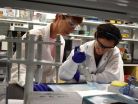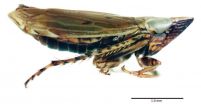(Press-News.org) Studying brain scans and cerebrospinal fluid of healthy adults, scientists have shown that changes in key biomarkers of Alzheimer's disease during midlife may help identify those who will develop dementia years later, according to new research.
The study, at Washington University School of Medicine in St. Louis, is published July 6 in JAMA Neurology.
"It's too early to use these biomarkers to definitively predict whether individual patients will develop Alzheimer's disease, but we're working toward that goal," said senior author Anne Fagan, PhD, a professor of neurology. "One day, we hope to use such measures to identify and treat people years before memory loss and other cognitive problems become apparent."
The study focused on data gathered over 10 years and involved 169 cognitively normal research participants ages 45 to 75 when they entered the study. Each participant received a complete clinical, cognitive imaging and cerebrospinal fluid biomarker analysis every three years, with a minimum of two evaluations.
At the participants' initial assessments, researchers divided them into three age groups: early-middle age (45-54); mid-middle age (55- 64); and late-middle age (65-74).
Among the biomarkers evaluated in the new study were:
Amyloid beta 42, a protein that is the principal ingredient of Alzheimer's plaques;
Tau, a structural component of brain cells that increases in the cerebrospinal fluid as Alzheimer's disease damages brain cells;
YKL-40, a newly recognized protein that is indicative of inflammation and is produced by brain cells; and
The presence of amyloid plaques in the brain, as seen via amyloid PET scans.
The scientists found that drops in amyloid beta 42 levels in the cerebrospinal fluid among cognitively normal participants ages 45-54 are linked to the appearance of plaques in brain scans years later. The researchers also found that tau and other biomarkers of brain-cell injury increase sharply in some individuals as they reach their mid-50s to mid-70s, and YKL-40 rises throughout the age groups focused on in the study.
Previous research has shown that all of these biomarkers may be affected by Alzheimer's disease, but this is the first large data set to show that the biomarkers change over time in middle-aged individuals.
All of these changes were more pronounced in participants who carried a form of a gene that significantly increases the risk of Alzheimer's disease. The gene is known as APOE, and scientists have known that people with two copies of a particular version of this gene have up to 10 times the risk of developing Alzheimer's as those with other versions of the gene.
The data came from the ongoing Adult-Children Study at the university's Charles F. and Joanne Knight Alzheimer's Disease Research Center. Scientists have been following participants with and without a family history of the disease, with the aim of identifying Alzheimer's biomarkers most closely associated with the development of full-blown disease years later.
"Alzheimer's is a long-term process, and that means we have to observe people for a long time to catch glimpses of it in action," Fagan said.
INFORMATION:
This research was supported by the National Institutes of Health (NIH), grants PO1AGO26276 and 5P30 NS048056; The Foundation for Barnes-Jewish Hospital; the Fred Simmons and Olga Mohan Fund; and Eli Lilly and Co.
Sutphen CL, Jasieler MS, Shah AR, Macy EM, Xiong C, Vlassenko AG, Benzinger TLS, Stoops EEJ, Vanderstichele HMJ, Brix B, Darby HD, Vandijck MLJ, Ladenson JH, Morris JC, Holtzman DM, Fagan AM. Longitudinal cerebrospinal fluid biomarker changes in preclinical Alzheimer's disease during middle age. JAMA Neurology, online July 6.
Washington University School of Medicine's 2,100 employed and volunteer faculty physicians also are the medical staff of Barnes-Jewish and St. Louis Children's hospitals. The School of Medicine is one of the leading medical research, teaching and patient-care institutions in the nation, currently ranked sixth in the nation by U.S. News & World Report. Through its affiliations with Barnes-Jewish and St. Louis Children's hospitals, the School of Medicine is linked to BJC HealthCare.
A blood-borne molecule that increases in abundance as we age blocks regeneration of brain cells and promotes cognitive decline, suggests a new study by researchers at UC San Francisco and Stanford School of Medicine.
The molecule in question, known as beta-2 microglobulin, or B2M, is a component of a larger molecule called MHC I (major histocompatibility complex class I), which plays a major role in the adaptive immune system. A growing body of research indicates that the B2M-MHC I complex, which is present in all cells in the body except red blood cells and plasma cells, ...
What gives plastic objects their flexibility and reduces their brittleness is the concentration of plasticiser. For example, a chemical solvent of the phthalate family called DOP is often used. The trouble is there are concerns that phthalates present health risks. So there is a demand for more alternatives. Now, scientists from China have examined the effect of using DEHHP, a new eco-friendly plasticiser, used in combination with PVC. For a plasticiser to work, there has to be adequate hydrogen bonding with the plastic. By combining experiments and simulations, the team ...
Nearly 800 million people worldwide don't have access to safe drinking water, and some 2.5 billion people live in precariously unsanitary conditions, according to the Centers for Disease Control and Prevention. Together, unsafe drinking water and the inadequate supply of water for hygiene purposes contribute to almost 90% of all deaths from diarrheal diseases -- and effective water sanitation interventions are still challenging scientists and engineers.
A new study published in Nature Nanotechnology proposes a novel nanotechnology-based strategy to improve water filtration. ...
Optogenetics techniques, which allow scientists to map and control nerve cells using light stimulation, are being used to study neural circuits in the brain with unprecedented precision. This revolutionary technology relies on light-sensitive proteins such as channelrhodopsins, and researchers at UC Santa Cruz have now determined the molecular mechanism involved in the light-induced activation of one of these proteins.
The new findings, published July 3 in two papers in the Journal of Biological Chemistry, can help scientists create tailor-made proteins optimized for ...
Evolutionary change in a gene resurrected in the lab from the extinct woolly mammoth altered the gene's temperature sensitivity and likely was part of a suite of adaptations that allowed the mammoth to survive in harsh arctic environments, according to new research. In a study published in Cell Reports on July 2, 2015, researchers determined the whole-genome sequence of two woolly mammoths and three modern Asian elephants, predicted the function of genetic changes found only in the mammoths, and then experimentally validated the function of a woolly mammoth gene reconstructed ...
An international team, led by a University of Adelaide genetics expert, has made a breakthrough discovery which is expected to help thousands of young girls worldwide who are suffering from a rare yet debilitating form of epilepsy.
Professor Jozef Gecz, from the University of Adelaide's Robinson Research Institute, was a key player in identifying the responsible gene and mutations in this female-only epileptic syndrome, in 2008.
In breakthrough research published in Oxford Journals, Human Molecular Genetics, Professor Gecz has now found a treatment for this disorder. ...
(PHILADELPHIA) -- Transfer RNAs (tRNAs) are ancient molecules and indispensable components of all living cells - they are found in all three kingdoms of life i.e., in archaea, bacteria and eukaryotes. In a cell, they are part of the machinery that translates messenger RNA (mRNA) sequences into amino acid sequences.
In recent years advances in sequencing technology have enabled detailed investigations of the RNA molecules that are active in a cell. A study published July 6th in the journal Oncotarget reports on a newly discovered category of tRNA fragments as well as ...
Andrew Hicks from the Museum of Natural History at the University of Colorado and his team discovered a previously unknown leafhopper species in the New Jersey Pine Barrens, located just east of the megalopolis that extends from New York City to Washington, DC. This was the first time an insect has been reported from the state-listed threatened pinebarren smokegrass, Muhlenbergia torreyana. The study can be found in the open-access journal ZooKeys.
The discovery was made with the help of Dr. Gerry Moore of the Natural Resources Conservation Service in Greensboro, NC, ...
Young children, who possess a good understanding of their own emotions and of those of their fellow human beings early on, suffer fewer attention problems than their peers with a lower emotional understanding. Evidence of this phenomenon was found through a study of Leuphana University of Lueneburg and George Mason University, USA, under the auspices of Prof. Dr. Maria von Salisch, Professor of Developmental Psychology at Leuphana University of Lueneburg. The study was recently published in the journal Kindheit & Entwicklung (Childhood & Development).
The findings stem ...
Results of EORTC trial 62072 appearing in Cancer show that in patients with soft tissue sarcoma, whose disease had progressed during or after prior chemotherapy, pazopanib improved progression-free survival but did not change health-related quality of life. This observed improvement in progression-free survival without impairment of health-related quality of life was considered a meaningful result.
There has not been a lot of research that has looked into the quality of life of patients with advanced soft tissue sarcoma. The results of this EORTC health related quality ...


